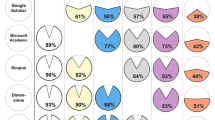Abstract
Previous attempts to map science using the co-citation clustering methodology are reviewed, and their shortcomings analyzed. Two enhancements of the methodology presented in Part I of the paper-fractional citation counting and variable level clustering—are briefly described and a third enhancement, the iterative clustering of clusters, is introduced. When combined, these three techniques improve our ability to generate comprehensive and representative mappings of science across the multidisciplinaryScience Citation Index (SCI) data base. Results of a four step analysis of the 1979SCI are presented, and the resulting map at the fourth iteration is described in detail. The map shows a tightly integrated network of approximate disciplinary regions, unique in that for the first time links between mathematics and biomedical science have brought about a closure of the previously linear arrangement of disciplines. Disciplinary balance between biomedical and physical science has improved, and the appearance of less cited subject areas, such as mathematics and applied science, makes this map the most comprehensive one yet produced by the co-citation methodology. Remaining problems and goals for future work are discussed.
Similar content being viewed by others
References
D. DE SOLLA PRICE, The Science of Scientists,Medical Opinion and Review 1, No. 10 (1966) 95.
D. DE SOLLA PRICE, The Citation Cycle, in:Key Papers in Information Science, B. C. GRIFFITH, (Ed.), Knowledge Industry Publications, White Plains NY, 1980, p. 195–210.
D. DE SOLLA PRICE, D. DE B. BEAVER, Collaboration in an Invisible College,American Psychologist, 21, No. 11 (1966) 1011.
H. SMALL, E. SWEENEY, Clustering theScience Citation Index ® using co-citations. Part I. A comparison of methods,Scientometrics, 7 (1985) 391.
H. SMALL, B. C. GRIFFITH, The structure of scientific literatures, I. Identifying and graphing specialties,Science Studies, 4 (1974) 17.
B. C. GRIFFITH, H. SMALL, J. A. STONHILL, S. DEY, The structure of scientific literatures, II. Toward a macro- and microstructure for science,Science Studies, 4 (1974) 339.
S. AARONSON, The footnotes of science,Mosaic, 6, No. 2 (1975) 22.
N. WADE, Citation analysis: A new tool for science administrators,Science, 188 (1975) 429.
J. B. KRUSKAL, Multidimensional scaling by optimizing goodness-of-fit to a non-metric hypothesis,Psychometrika, 29 (1964) 1.
E. GARFIELD, M. V. MALIN, H. G. SMALL, Citation data as science indicators, in:Toward a Metric of Science: The Advent of Science Indicators, Y. ELKANA (Ed.), John Wiley, New York, 1978, p. 179–207.
H. SMALL, Structural dynamics of scientific literature,International Classification, 3, No. 2 (1976) 67.
E. GARFIELD,ISI Atlas of Science: Biochemistry and Molecular Biology, Institute for Scientific Information, Philadelphia, 1981.
E. GARFIELD, ISI's on-line system makes searching so easy even a scientist can do it: Introducing METADEX Automatic Indexing and ISI/BIOMED SEARCH,Current Contents ® (Editorial), 26 January 1981, reprinted in:Essays of an Information Scientist, ISI Press, Philadelphia Vol. 5, 1983, p. 11–14.
E. GARFIELD,Index Chemicus goes online with graphic access to three million new organic compounds,Current contents ® (Editorial) (25 June 1984) 3.
F. NARIN,Evaluative Bibliometrics: The Use Of Publication and Citation Analysis in the Evaluation of Scientific Activity, Final report on NSF Contract c-627, Computer Horizons Incorporated, Cherry Hill, NJ, 1976.
S. MIYAMOTO, K. NAKAYAMA, A technique of two-stage clustering applied to environmental and civil engineering and related methods of citation analysis,Journal of the American Society for Information Science, 34 No. 3 (1983) 192.
B. C. GRIFFITH, H. D. WHITE, Authors as makers of intellectual Space: Co-citation in studies of science, technology and society,Journal of Documentation, 38, No. 4 (1983) 255.
G. SALTON, D. BERGMARK, A citation study of computer science literature,IEEE Transactions on Professional Communication, PC-22, No. 3 (1979) 146.
H. SMALL, H. R. COWARD, M. C. DEAN, E. J. GREENLEE, S. E. COZZENS,Co-citation clusters as indicators of speciality development, Final Report on NSF GRANT SRS-7912157, Institute for Scientific Information, Philadelphia, 1983.
C. F. HEROT, Spatial management of data,ACM Transactions on Database Systems, 5, No. 4 (1980) 493.
E. GARFIELD, ‘World brain’ or ‘Memex’? Mechanical and intellectual requirements for universal bibliographic control, in:The Foundations of Access to Knowledge, E. B. MONTGOMERY (Ed.), Syracuse University Press, New York, 1968, p. 169.
Author information
Authors and Affiliations
Rights and permissions
About this article
Cite this article
Small, H., Sweeney, E. & Greenlee, E. Clustering the science citation index using co-citations. II. Mapping science. Scientometrics 8, 321–340 (1985). https://doi.org/10.1007/BF02018057
Received:
Issue Date:
DOI: https://doi.org/10.1007/BF02018057




